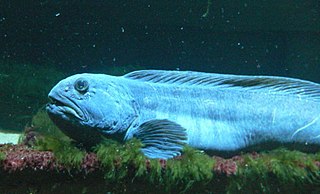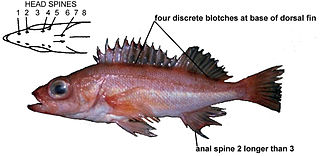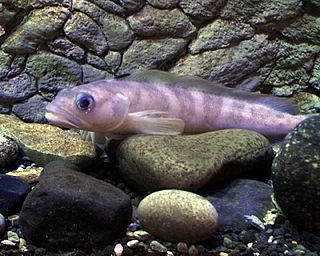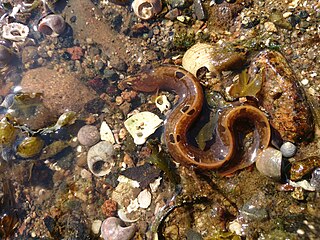
The viviparous eelpout, also known as the, viviparous blenny and European eelpout is species of marine ray-finned fish belonging to the family Zoarcidae, the eelpouts. It is notable for being ovoviviparous and gives birth to live larvae. It is a common soup ingredient in Mediterranean countries. The bones are of greenish colour, due to a harmless pigment. Their skin is slimy and the colour is variable.

Anarhichadidae, the wolffishes, sea wolves or wolf eels, is a family of marine ray finned fishes belonging to the order Scorpaeniformes. These are predatory, eel shaped fishes which are native to the cold waters of the Arctic, North Pacific and North Atlantic Oceans.

Pholidae is a family of marine ray-finned fishes, known as gunnels, in the scorpaeniform suborder Zoarcoidei. These are fishes of the littoral zone and are mainly found in North Pacific Ocean, with two species found in the North Atlantic Ocean and Arctic Ocean.

Bathymaster signatus, the searcher, is species of marine ray-finned fish belonging to the family Bathymasteridae, the ronquils. This species is found in the northern Pacific Ocean.

Anarhichas is a genus of marine ray-finned fishes belonging to the family Anarhichadidae, the wolffishes or sea wolves. These fishes are found in the northern North Atlantic and North Pacific oceans.

The pygmy rockfish, also known as the slender rockfish or Wilson's rockfish, is a species of marine ray-finned fish belonging to the subfamily Sebastinae, the rockfishes, part of the family Scorpaenidae. It is found in the eastern Pacific Ocean.

The penpoint gunnel is a species of marine ray-finned fish belonging to the family Pholidae, the gunnels. This fish occurs in the eastern North Pacific Ocean.

Lipophrys pholis, commonly known as shanny, also known as the smooth blenny or common blenny, is a species of combtooth blenny. It matures at two years of age. Distributed in the Eastern Atlantic from the southern Norway to Morocco and Madeira, including the Mediterranean and the Balearics. Lipophrys pholis feed primarily on crustaceans, but also feed on other invertebrates and plants.

Montagu's blenny, also known as the capuchin blenny, is a species of combtooth blenny found in the intertidal zones of the eastern Atlantic ocean from England to Madeira and the Canary Islands as well the Mediterranean Sea, the Black Sea and the Sea of Marmara. This species prefers rocky shores with much wave action. This species grows to a length of 7.6 centimetres (3.0 in) SL. It is the only species in the genus Coryphoblennius.
Pholis fasciata, the banded gunnel, is a species of marine ray-finned fish belonging to the family Pholidae, the gunnels. It is found in the North Pacific, Arctic and western North Atlantic Oceans. Very little is known about its life cycle or reproduction.

Clinocottus globiceps, the mosshead sculpin or globe-headed sculpin, is a species of marine ray-finned fish belonging to the family Cottidae, the typical sculpins. This sculpin is found in the northeastern Pacific.

Bathymaster is a genus of marine ray-finned fishes belonging to the family Bathymasteridae, the ronquils. These fishes are found in the northern Pacific Ocean.

The rock gunnel, or butterfish, is a species of marine ray-finned fish belonging to the family Pholidae, the gunnels. This species is found in the coastal waters of the North Atlantic Ocean and in the Atlantic part of the Arctic Ocean.

The rockweed gunnel, also known as the Fucus blenny, is a species of marine ray-finned fish belonging to the family Pholidae, the gunnels. This species is found in the eastern North Pacific Ocean.

Sebastes taczanowskii, the white-edged rockfish, is a species of marine ray-finned fish belonging to the subfamily Sebastinae, the rockfishes, part of the family Scorpaenidae. It is native to the northwestern Pacific Ocean from northern Japan and far eastern Russia, it has also been reported from Korea. This species was first formally described in 1880 by the Austrian ichthyologist Franz Steindachner with the type locality given as Northern Japan. The identity of the person honoutred in its specific name is not certain but is thought likely to be the Polish zoologist Władysław Taczanowski, who possibly gave Steindachner the type which had been collected by another Polish zoologist, Benedykt Dybowski. Some authorities place this species in the subgenus Mebarus.This demersal fish is found in shallow waters near coasts and will enter estuaries and the juveniles live among floating seaweed. It is an ovoviviparous species. This species attains a maximum total length of 32 cm (13 in).

The saddleback gunnel, also known as the saddled blenny, is a species of marine ray-finned fish belonging to the family Pholidae, the gunnels. This fish occurs in the shallow coastal waters of the eastern North Pacific Ocean.

Pholis is a genus of marine ray-finned fish belonging to the family Pholidae, the gunnels. These fishes are found in shallow coastal waters of the North Pacific, Arctic and North Atlantic Oceans.
The stippled gunnel is a species of marine ray-finned fish belonging to the family Pholidae, the gunnels. It is the only species in the monospecific genus Rhodymenichthys. It is found in the northern North Pacific Ocean.
The kelp gunnel is a species of marine ray-finned fish belonging to the family Pholidae, the gunnels. It is the only species in the monospecific genus Ulvicola. It is found in the eastern North Pacific Ocean.
The radiated shanny is a species of marine ray-finned fish belonging to the family Stichaeidae, the pricklebacks and shannies. It is the only species in the monotypic genus Ulvaria. This fish is found in the northwestern Atlantic Ocean.

















